1. 环境搭建
1.1 新建一个vite搭建的vue3项目
先执行以下命令
npm create vite@latest my-project(你的项目名)
1.2 选择项目框架 vue
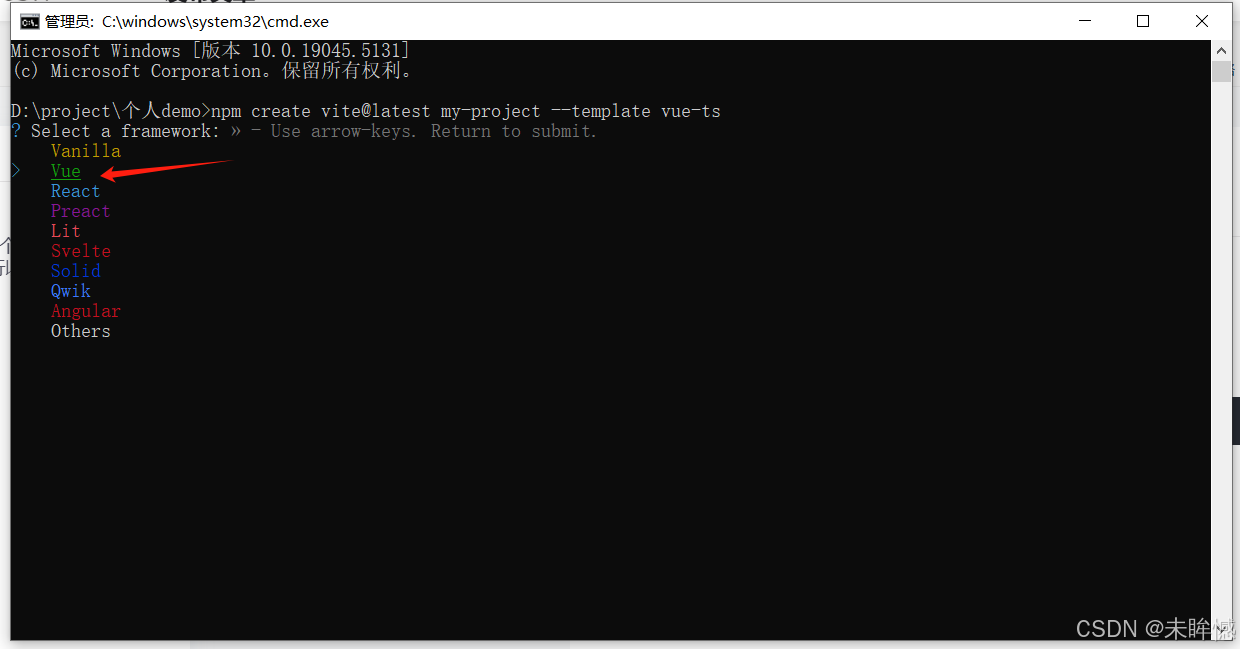
1.3 选择语言类型 ts
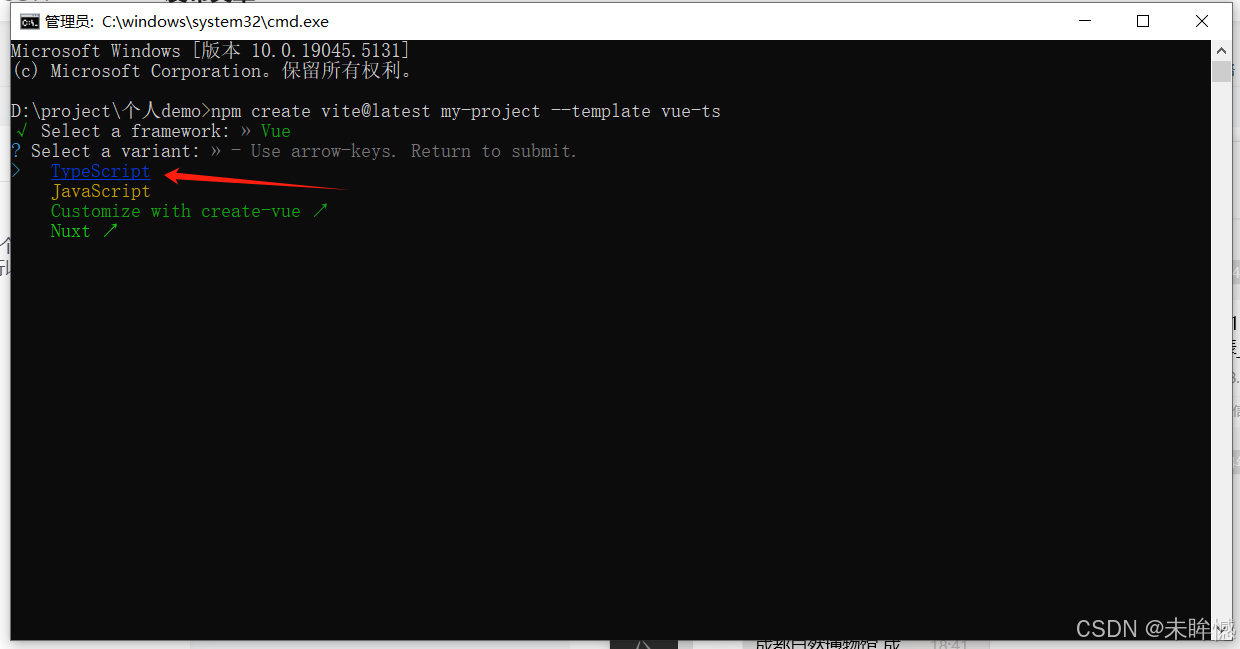
1.4 执行命令进入到新建的项目文件中
cd my-project
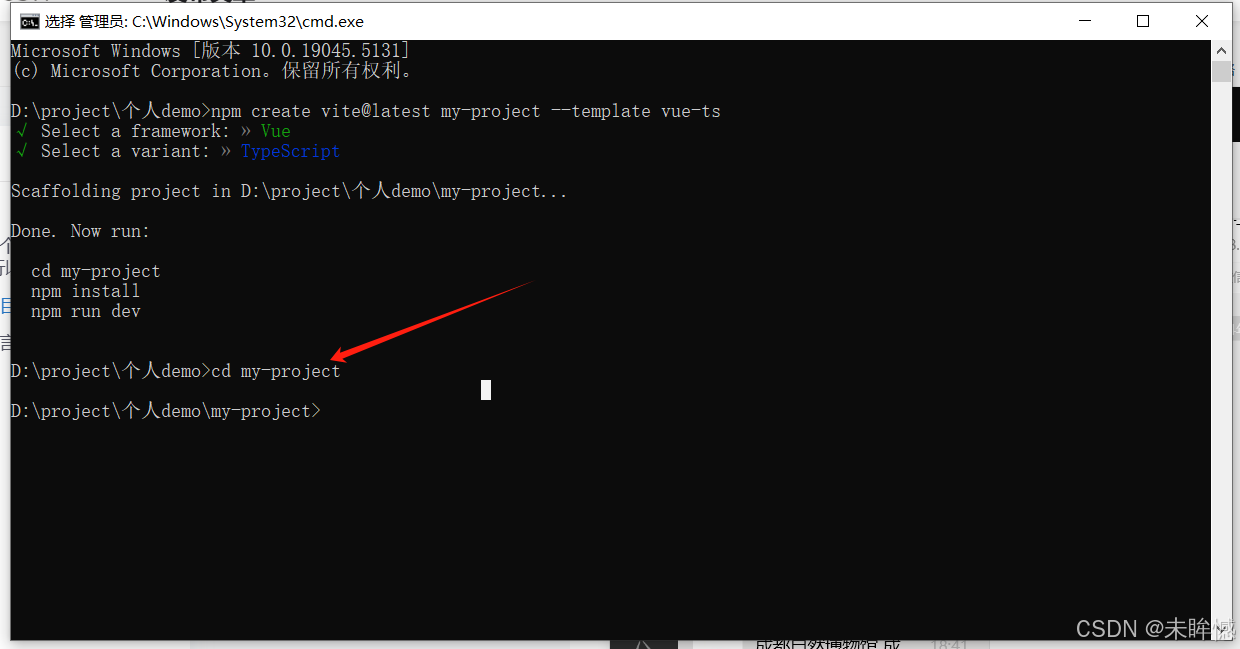
1.5 下载依赖
npm i
下载项目中需要使用到的环境
npm install vue-router@4 pinia element-plus @element-plus/icons-vue
1.6 完善项目目录结构以及环境配置
1.6.1 先清空app.vue文件中内容,增加router-view作为路由出口
<template>
<router-view />
</template>
<script setup lang="ts">
</script>
<style scoped lang="scss">
#app {
width: 100vw;
height: 100vh;
display: flex;
justify-content: space-around;
}
</style>1.6.2 在src目录下新建文件夹layout,在该文件中新建文件applayout.vue (文件名看自己)
1.6.3 在src目录下分别新建文件夹store和router分别用来pinia状态管理和路由管理
1.6.3.1 router文件夹中新建两个文件一个index.ts用来初始化路由和存放静态路由一个dynamicroutes.ts存放处理动态路由
// router/dynamicroutes.ts
// 更新 initdynamicroutes,确保 dynamicroutes 被更新
import router from './index';
import { useroutestore } from '@/store/index'; // 导入 store
import type { routerecordraw, routerecordredirectoption } from 'vue-router';
// 定义菜单项类型,确保 `name` 是 `string`
type menuitem = omit<routerecordraw, 'component' | 'children' | 'redirect'> & {
name: string; // 必须有 name 属性
path: string; // 必须有 path 属性
component?: () => promise<component>; // 用于动态加载组件的路径
children?: menuitem[]; // 子路由类型
redirect?: string; // 调整 redirect 为更简单的 string 类型
meta?: {
title: string;
};
};
// vite 支持使用特殊的 import.meta.glob 函数从文件系统导入多个模块
const modules: record<string, () => promise<component>> = import.meta.glob('../views/**/**.vue');
// 初始化动态路由
export const initdynamicroutes = (menudata: menuitem[]) => {
const routestore = useroutestore(); // 获取 store
const routerlist: menuitem[] = [];
const addedroutes = new set(); // 用于跟踪已添加的路由,防止重复添加
// 递归处理路由
const processroutes = (routes: menuitem[]): menuitem[] => {
return routes.map((item) => {
if (addedroutes.has(item.name)) return null; // 防止重复处理
addedroutes.add(item.name); // 标记路由为已处理
const componentloader = modules[`../views${item.component}.vue`];
const route: menuitem = {
path: item.path,
name: item.name as string,
component: componentloader , // 提供默认组件以防找不到
meta: item.meta,
};
// 如果有子路由,递归处理
if (item.children && item.children.length > 0) {
route.children = processroutes(item.children);
route.redirect = route.children[0]?.path; // 默认重定向到第一个子路由
} else {
route.children = undefined; // 明确设置为 undefined
}
return route;
}).filter((route) => route !== null) as menuitem[]; // 过滤掉 null 项
};
// 顶级路由处理
const parentrouter = processroutes(menudata);
// 根路由配置
routerlist.push({
path: '/',
name: 'home',
component: () => import('../layout/applayout.vue'),
children: parentrouter, // 顶级路由作为子路由
redirect: parentrouter[0]?.path || '/', // 确保有默认重定向路径
});
// 将路由存储到 store 中
routestore.dynamicroutes = routerlist;
// 添加路由到 vue router
routerlist.foreach((route) => {
router.addroute(route as routerecordraw);
});
};// router/index.ts
import { createrouter, createwebhashhistory, routerecordraw } from "vue-router";
import { useroutestore } from "@/store";
// 静态路由
const routes: routerecordraw[] = [
{
path: "/login",
name: "login",
component: () => import("@/views/login/index.vue"),
},
{
path: "/404",
component: () => import("@/views/error-page/404.vue"),
},
{
path: "/401",
component: () => import("@/views/error-page/401.vue"),
},
// 匹配所有路径
{ path: "/:pathmatch(.*)", redirect: "/login" },
];
// 创建路由
const router = createrouter({
history: createwebhashhistory(), // 路由模式
routes, // 静态路由
});
// 路由守卫:初始化时跳转到上次访问的页面
window.addeventlistener('domcontentloaded', () => {
const routestore = useroutestore()
const beforereloadroute = sessionstorage.getitem('beforereloadroute')
if (beforereloadroute) {
const to = json.parse(beforereloadroute)
routestore.beforerouter = to.path
// 清除保存的路由信息
sessionstorage.removeitem('beforereloadroute')
// 导航回刷新前的路由
router.replace(to)
const keys = object.keys(to)
if (keys.includes('name')) {
sessionstorage.setitem('roterpath', json.stringify(to.name))
}
}
})
// 在页面即将刷新时保存当前路由信息
window.addeventlistener('beforeunload', () => {
const currentroute = json.stringify(router.currentroute.value)
sessionstorage.setitem('beforereloadroute', currentroute)
})
export default router;1.6.3.2 实现路由持久化和白名单,需要在src目录下新建一个permission.ts文件
import { createvnode, render } from 'vue';
import { initdynamicroutes } from '@/router/dynamicroutes';
import router from './router/index';
import loadingbar from '@/component/loadingbar.vue';
import cookies from 'js-cookie'; // 引入 js-cookie
import { useroutestore } from '@/store/index';
import menudata from '/public/dynamicrouter.json'; // 导入动态菜单数据
const whilelist = ['/login']; // 白名单
const vnode = createvnode(loadingbar);
render(vnode, document.body);
router.beforeeach(async (to, from, next) => {
const routestore = useroutestore(); // 获取 pinia 中的路由状态
const token = cookies.get('token'); // 从 cookie 获取 token
// 判断是否有 token,存在则说明用户已登录
if (token) {
// 检查是否已经加载过动态路由
if (routestore.dynamicroutes.length === 0) {
// 检查是否有持久化的动态路由
const persistedroutes = sessionstorage.getitem('dynamicroutes'); // 使用 sessionstorage
if (persistedroutes) {
// 如果有持久化的动态路由,直接从 sessionstorage 加载
const routerlist = json.parse(persistedroutes);
initdynamicroutes(routerlist); // 动态初始化路由
routestore.setdynamicroutes(routerlist); // 将动态路由存入 pinia
next({ ...to, replace: true }); // 确保动态路由加载后再跳转
vnode.component?.exposed?.startloading(); // 启动加载条
} else {
// 如果没有持久化的动态路由,则使用静态的 dynamicrouter.json
const dynamicroutes = initdynamicroutes(menudata); // 动态初始化路由
if (dynamicroutes !== undefined) {
routestore.setdynamicroutes(dynamicroutes); // 将动态路由存入 pinia
sessionstorage.setitem('dynamicroutes', json.stringify(dynamicroutes)); // 存储动态路由到 sessionstorage
next({ ...to, replace: true }); // 确保动态路由加载后再跳转
vnode.component?.exposed?.startloading(); // 启动加载条
} else {
next('/login'); // 如果没有动态路由信息,跳转到登录页面
}
}
} else {
next(); // 如果已经加载过动态路由,直接跳转
}
} else {
// 如果没有 token,判断是否在白名单中
if (whilelist.includes(to.path)) {
next(); // 白名单路由放行
} else {
next('/login'); // 否则跳转到登录页
}
}
});
router.aftereach(() => {
vnode.component?.exposed?.endloading(); // 结束加载条
});1.6.3.2 store文件夹下新建文件index.ts初始化pinia仓
// store/index.ts
import { createpinia } from 'pinia';
import { useroutestore } from './useroutestore';
import { useuserstore } from './tokenstore';
// 创建 pinia 实例
const pinia = createpinia();
// 将所有 store 模块暴露
export { pinia, useroutestore, useuserstore };1.6.3.2 store文件夹下新建文件useroutestore.ts处理存储动态路由文件
import { definestore } from 'pinia';
import { ref } from 'vue';
import { initdynamicroutes } from "@/router/dynamicroutes"; // 导入初始化动态路由的方法
import type { routerecordraw, routerecordredirectoption } from 'vue-router';
// 定义菜单项类型,确保 `name` 是 `string`
type menuitem = omit<routerecordraw, 'component' | 'children' | 'redirect'> & {
name: string; // 必须有 name 属性
path: string; // 必须有 path 属性
component?: () => promise<component>; // 用于动态加载组件的路径
children?: menuitem[]; // 子路由类型
redirect?: string; // 调整 redirect 为更简单的 string 类型
meta?: {
title: string;
};
};
// 定义路由数据 store
export const useroutestore = definestore('route', () => {
// 存储菜单数据
const menudata = ref<menuitem[]>([]); // 根据你的菜单数据结构调整类型
// 存储动态路由数据
const dynamicroutes = ref<menuitem[]>([]);
// 存储是否已初始化路由的状态
const isroutesinitialized = ref<boolean>(false);
// 存储上一次页面刷新的路由
const beforerouter = ref<string>('');
// 初始化动态路由
const setdynamicroutes = (menu: any[]) => {
// 只在未初始化路由时执行
if (!isroutesinitialized.value) {
// 调用 initdynamicroutes 函数来生成动态路由
initdynamicroutes(menu);
// 将菜单数据存储到状态中
menudata.value = menu;
// 设置已初始化状态
isroutesinitialized.value = true;
}
};
// 获取动态路由
const getdynamicroutes = () => {
return dynamicroutes.value;
};
// 更新动态路由
const setupdateddynamicroutes = (routes: menuitem[]) => {
dynamicroutes.value = routes;
};
return {
menudata,
dynamicroutes,
isroutesinitialized, // 公开这个状态,方便其他地方判断
setdynamicroutes,
getdynamicroutes,
setupdateddynamicroutes, // 更新动态路由的函数
beforerouter
};
});1.6.4 在src目录下新建文件夹plugins,在该文件夹中新建文件element-plus.ts
/* element-plus组件库 */
import elementplus from 'element-plus'
import 'element-plus/dist/index.css'
import zhcn from 'element-plus/es/locale/lang/zh-cn'
import { app } from 'vue'
export default {
install (app: app) {
app.use(elementplus, {
locale: zhcn
})
}
}1.6.5 需要来配置main.ts,vite.config.ts以及tsconfig.json
1.6.5.1 main.ts配置
import { createapp } from "vue";
import app from "./app.vue";
import router from "./router/index";
import elementplus from "./plugins/element-plus";
import * as elementplusiconsvue from "@element-plus/icons-vue";
import { pinia } from '@/store/index'; // 导入 store
// 创建 pinia 实例
// 路由拦截 路由发生变化修改页面title
router.beforeeach((to, from, next) => {
if (to.meta.title) {
document.title = to.meta.title;
}
next();
});
const app = createapp(app);
// // 自动注册全局组件
app.use(router).use(elementplus).use(pinia).mount("#app");
for (const [key, component] of object.entries(elementplusiconsvue)) {
app.component(key, component);
}1.6.5.2 vite.config.ts配置
import { defineconfig } from 'vite'
import vue from '@vitejs/plugin-vue'
import path from 'path'
export default defineconfig({
plugins: [vue()],
resolve: {
alias: {
// 设置别名 方便路径引入
'@': path.resolve(__dirname, 'src'),
}
}
})1.6.5.3 tsconfig.json配置
{
"compileroptions":
{
"target": "esnext",
"usedefineforclassfields": true,
"module": "esnext",
"moduleresolution": "node",
"strict": true,
"jsx": "preserve",
"sourcemap": true,
"resolvejsonmodule": true,
"isolatedmodules": true,
"esmoduleinterop": true,
"lib": ["esnext", "dom"],
"skiplibcheck": true,
"noemit": true,
"paths": {
"@/*": ["./src/*"] // 配置路径别名,不做配置会报错
}
//就是这个没有设置导致的
},
// "extends": "./tsconfig.extends.json",
"include": ["src/**/*.tsx","src/**/*.ts", "src/**/*.d.ts", "src/**/*.vue"],
"references": [{ "path": "./tsconfig.node.json" }]
}1.6.5.4 此外vue3在插件引入时有些时候会报错无法找到模块“xxx”的声明文件,此时需要在src目录下新建一个env.d.ts文件
/// <reference types="vite/client" />
// 类型补充、环境变量
declare module "*.vue" {
import type { definecomponent } from "vue";
// eslint-disable-next-line @typescript-eslint/no-explicit-any, @typescript-eslint/ban-types
const component: definecomponent<{}, {}, any>;
export default component;
}
// eslint-disable-next-line no-unused-vars
interface importmetaenv {
readonly vite_app_title: string;
readonly vite_api_baseurl: string;
// 更多环境变量...
}
// 如果遇到路径缺失找不到的情况
// 无法找到模块“xxx”的声明文件,就将该模块加入到下列代码中进行补充声明
declare module "xxxx";1.7 因为考虑是纯前端模拟后端给的路由数据
所以我自己模拟一个json文件,需在public文件夹中新建dynamicrouter.json来存放模拟后端返回的路由数据,后期从接口获取可进行更改
[
{
"path": "/principle",
"name": "principle",
"component": "/principle/index",
"meta": {
"title": "vue3响应式原理"
}
},
{
"path": "/ref",
"name": "ref",
"meta": {
"title": "ref类"
},
"children": [
{
"path": "/ref/index",
"name": "ref",
"component": "/ref/common/ref",
"meta": {
"title": "ref"
}
},
{
"path": "/ref/toraw",
"name": "toraw",
"component": "/ref/common/toraw",
"meta": {
"title": "toraw"
}
},
{
"path": "/ref/toref",
"name": "toref",
"component": "/ref/common/toref",
"meta": {
"title": "toref"
}
},
{
"path": "/ref/torefs",
"name": "torefs",
"component": "/ref/common/torefs",
"meta": {
"title": "torefs"
}
},
{
"path": "/ref/isref",
"name": "isref",
"component": "/ref/no-common/isref",
"meta": {
"title": "isref"
}
},
{
"path": "/ref/ref",
"name": "ref",
"component": "/ref/no-common/ref",
"meta": {
"title": "ref"
}
},
{
"path": "/ref/shallowref",
"name": "shallowref",
"component": "/ref/no-common/shallowref",
"meta": {
"title": "shallowref"
}
},
{
"path": "/ref/triggerref",
"name": "triggerref",
"component": "/ref/no-common/triggerref",
"meta": {
"title": "triggerref"
}
}
]
}
]如下是文件对应的位置
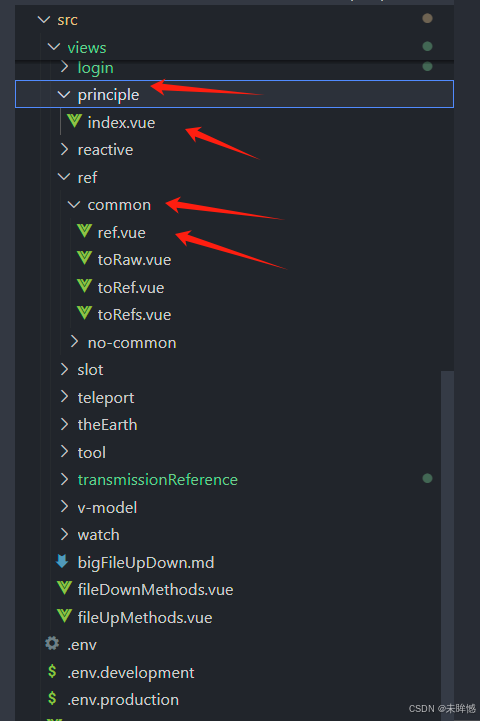
到目前为止整体的环境已经搭建完善,大概结构如下
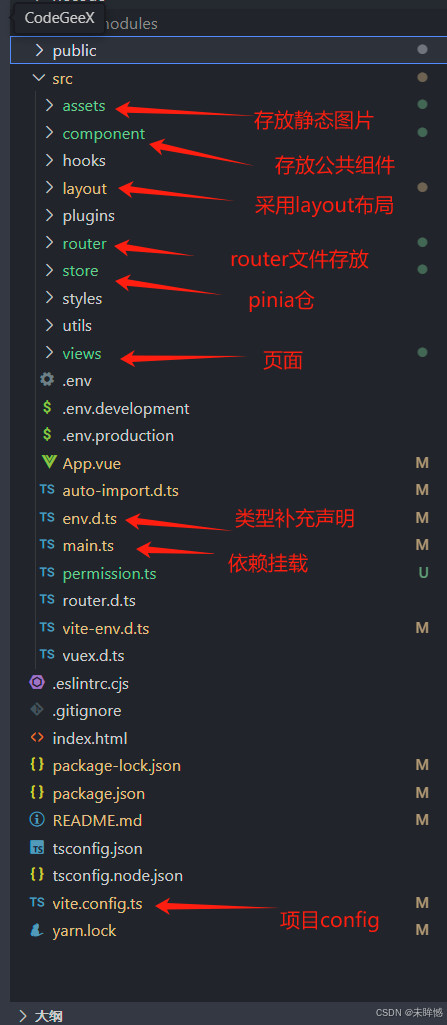
2. 在views文件夹下新建文件夹login
在其中新建文件index.vue
<template>
<div class="login">
//登录框
<div class="loginpart">
<h2>用户登录</h2>
<el-form
ref="ruleformref"
:model="user"
status-icon
:rules="rules"
label-width="100px"
class="demo-ruleform"
style="transform: translate(-30px)"
>
<el-form-item
label="账号:"
prop="account"
>
<el-input
v-model="user.account"
placeholder="请输入账号"
maxlength="20"
clearable
/>
</el-form-item>
<el-form-item
label="密码:"
prop="password"
>
<el-input
v-model="user.password"
type="password"
placeholder="请输入密码"
maxlength="20"
show-password
clearable
/>
</el-form-item>
<el-button
class="btn"
type="primary"
@click="onsubmit(ruleformref)"
>
登录
</el-button>
</el-form>
</div>
</div>
</template>
<script setup lang="ts">
import { reactive, ref, onmounted } from "vue";
//导入模拟的动态路由数据
import menudata from '/public/dynamicrouter.json'; // 导入动态菜单数据
import { elmessage, type forminstance } from "element-plus";
import { userouter } from "vue-router";
import { initdynamicroutes } from "@/router/dynamicroutes"; // 导入初始化动态路由的方法
import { useroutestore, useuserstore} from "@/store";
const router = userouter();
const routestore = useroutestore();
const userstore = useuserstore();
type loginreq = {
account: string;
password: string;
};
onmounted(() => {});
//from表单校验
const ruleformref = ref<forminstance>();
// 这里存放数据
const user = reactive<loginreq>({
account: "admin",
password: "123456",
});
const users = reactive<loginreq>({
account: "admin",
password: "123456",
});
//校验
const validatepassword = (rule: any, value: any, callback: any) => {
if (value === "") {
callback(new error("请输入密码"));
} else {
callback();
}
};
const validateaccount = (rule: any, value: any, callback: any) => {
if (value === "") {
callback(new error("请输入账号"));
} else {
callback();
}
};
//校验
const rules = reactive({
password: [{ validator: validatepassword, trigger: "blur" }],
account: [{ validator: validateaccount, trigger: "blur" }],
});
const changeregist = () => {
router.replace("/regist");
};
const onsubmit = (formel: forminstance | undefined) => {
if (!formel) return;
formel.validate((valid) => {
if (valid) {
// 如果需要保存 token 或账户信息,存储在全局状态
// 假设这里会调用登录 api 返回一个 token
const token = "mock_token"; // 模拟登录后返回的 token
// 使用 pinia 保存 token,并设置到 cookie 中
// 存储在 cookie 中的 token 可以配合 httponly 和 secure 标志来增强安全性,
// 这样可以防止 xss 攻击并确保 token 只有在通过 https 协议时才会被发送
userstore.settoken(token);
elmessage.success("登录成功");
// 获取菜单数据
if(routestore.isroutesinitialized){
// 使用 nexttick 确保路由添加完成后再进行跳转
nexttick(() => {
// 跳转到首页或其他路由
router.push('/') // 假设 'home' 是你动态路由中的一个页面名称
.then(() => {
console.log('跳转成功');
})
.catch((error) => {
console.error('跳转失败', error);
});
});
}else{
initdynamicroutes(menudata)
// 标记路由已初始化
routestore.isroutesinitialized = true
// 使用 nexttick 确保路由添加完成后再进行跳转
nexttick(() => {
// 跳转到首页或其他路由
router.push('/') // 假设 'home' 是你动态路由中的一个页面名称
.then(() => {
console.log('跳转成功');
})
.catch((error) => {
console.error('跳转失败', error);
});
});
}
}
})
};
</script>
<style scoped lang="scss">
.login {
height: 100%;
width: 100%;
overflow: hidden;
}
.login__particles {
height: 100%;
width: 100%;
background-size: cover;
background-repeat: no-repeat;
background-image: url("@/assets/0001.jpg");
opacity: 0.9;
position: fixed;
pointer-events: none;
}
h2 {
margin: 0 0 30px;
padding: 0;
color: #fff;
text-align: center;
/*文字居中*/
}
.btn {
transform: translate(170px);
width: 80px;
height: 40px;
font-size: 15px;
}
</style>3. layout中制作动态路由菜单
<!-- 自定义编辑的样式不采用element-plus -->
<template>
<div class="app-container">
<header>
<div class="menu">
<el-col :span="24">
<el-menu
:router="true"
active-text-color="#ffd04b"
background-color="#545c64"
class="el-menu-vertical-demo"
text-color="#fff"
@open="handleopen"
@close="handleclose"
:unique-opened="true"
:default-active="defaultpath"
>
<div
v-for="(item, index) in menulist[0].children"
:key="index"
>
<el-menu-item
v-if="!item.children"
:index="item.path"
:route="item.path"
>
<!-- <el-icon><setting /></el-icon> -->
<span>{{ item.meta?.title }}</span>
</el-menu-item>
<el-sub-menu
v-if="item.children"
:index="item.path"
>
<template #title>
<!-- <el-icon><setting /></el-icon> -->
<span>{{ item.meta?.title }}</span>
</template>
<el-menu-item-group>
<el-menu-item
v-for="(child, childindex) in item.children"
:key="childindex"
:index="child.path"
>
{{ child.meta?.title }}
</el-menu-item>
</el-menu-item-group>
</el-sub-menu>
</div>
</el-menu>
</el-col>
</div>
</header>
<main>
<router-view />
</main>
</div>
</template>
<script lang="ts" setup>
import { computed, onmounted } from "vue";
import { useroutestore } from '@/store'; // 调整路径为实际 store 文件位置
import { userouter } from "vue-router";
const router = userouter()
const routestore = useroutestore();
const menulist = computed(() => routestore.dynamicroutes);
const defaultpath = ref<string>('')
const handleopen = (key: string, keypath: string[]) => {
console.log('key', key);
console.log('keypathpen', keypath);
};
const handleclose = (key: string, keypath: string[]) => {
console.log('close', key, keypath);
};
onmounted(() => {
defaultpath.value = routestore.beforerouter
});
</script>
<style lang="scss" scoped>
* {
margin: 0;
padding: 0;
box-sizing: border-box; /* 确保所有元素都遵循边框盒模型 */
touch-action: none;
}
.app-container {
display: flex; /* 使用 flexbox 创建左右布局 */
justify-content: space-between;
height: 100vh; /* 设置容器高度为视口高度 */
background-color: #fff;
}
header {
width: 150px; /* 固定宽度,左侧菜单栏宽度,可以根据需要调整 */
// background-color: #f8f9fa; /* 设置背景颜色 */
box-shadow: 2px 0px 10px rgba(0, 0, 0, 0.1); /* 给左侧菜单栏添加阴影 */
overflow-y: auto; /* 左侧菜单支持垂直滚动 */
height: 100vh; /* 使 header 高度占满整个屏幕 */
.el-menu {
height: 100vh; /* 高度占满全屏 */
width: 100%; /* 设置菜单宽度为220px,避免过窄 */
font-size: 0.175rem;
font-weight: bold;
color: #fff;
overflow-y: scroll;
/* 确保菜单项宽度一致 */
.el-menu-item,
.el-sub-menu {
width: 100%; /* 确保菜单项和子菜单项的宽度自适应 */
// padding-left: 0.25rem; /* 为每个菜单项增加左侧的内边距 */
}
/* 一级菜单项 */
.el-menu-item {
padding: 10px 20px; /* 设置内边距,避免菜单项过于拥挤 */
text-align: left; /* 左对齐文本 */
font-size: 0.175rem; /* 调整字体大小 */
}
/* 二级菜单项(子菜单) */
.el-sub-menu {
// padding-left: 10px; /* 为二级菜单增加缩进 */
background-color: #434d56; /* 给二级菜单背景设置一个较深的颜色 */
/* 子菜单项的缩进 */
.el-menu-item {
padding-left: 1rem; /* 设置二级菜单项的缩进,区别于一级菜单 */
}
}
/* 子菜单的展开箭头样式 */
:deep(.el-sub-menu__icon-arrow) {
color: #ffd04b; /* 设置箭头颜色为黄色 */
}
/* 设置展开状态时,子菜单的背景色变化 */
.el-sub-menu.is-opened {
background-color: #3a424a; /* 打开时的背景色 */
}
/* 设置菜单项和子菜单项的 hover 状态 */
.el-menu-item:hover,
.el-sub-menu:hover {
background-color: #333c44; /* 鼠标悬浮时的背景色 */
}
/* 设置当前激活的菜单项的背景颜色 */
.el-menu-item.is-active {
background-color: #ff6600; /* 激活状态的背景色 */
}
}
.el-menu::-webkit-scrollbar{
display: none;
}
/* 自定义子菜单图标大小 */
.el-menu-item .el-icon,
.el-sub-menu .el-icon {
font-size: 1.2rem; /* 调整图标的大小 */
margin-right: 0.5rem; /* 给图标增加右侧的间距 */
}
:deep(.el-sub-menu__title){
width: 100%!important;
}
.el-menu-item span,
.el-sub-menu span {
font-size: 10px; /* 设置文本的字体大小 */
font-weight: bold; /* 设置文本加粗 */
}
:deep(.el-sub-menu__icon-arrow){
left: 50px!important;
}
}
main {
display: flex;
flex: 1; /* main 占据剩余空间 */
// margin-left: 250px; /* 给 main 留出与 header 相同的空间 */
padding: 20px;
overflow-y: auto; /* 支持内容区域滚动 */
background-image: linear-gradient(135deg, #102363, #346177, #3fa489, #34ec98);
flex-direction: column;
}
header::-webkit-scrollbar, main::-webkit-scrollbar {
display: none; /* 隐藏滚动条 */
}
/* 小屏幕适配 */
@media (max-width: 768px) {
.app-container {
flex-direction: column; /* 在小屏幕下转换为上下布局 */
}
header {
width: 100%; /* 屏幕小于768px时,左侧菜单占满全宽 */
position: relative; /* 取消固定定位,方便移动 */
height: auto; /* 自动高度 */
}
main {
margin-left: 0; /* 小屏幕时不需要左侧留白 */
}
}
</style>总结
以上为个人经验,希望能给大家一个参考,也希望大家多多支持代码网。





发表评论